In September 2023, UKE (polish regulator) announced the availability of a dedicated mobile band for building a private network.
This is a good time to consider who needs private networks.
However, a more relevant question is how you can save or earn money on a private network.
This is also a good time to become aware of what such an investment entails from the business and technical perspective.
I’ll start with the business side.
From the perspective of the owner’s needs.
Who needs a mobile private network?
Is the desire to build a private network enough?
It’s not enough.
Why?
Because you have to invest a lot of money.
It will also be necessary to maintain and develop this network over the years.
Therefore, a good and profitable business reason is important.
The construction of a mobile network is similar to the construction of a large cellular network but on a micro-scale.
The scale is micro, but many of the mobile operator’s systems, procedures, and processes must be in place.
This means the need to master many technical, operational, and legal aspects.
Private network is a very hot topic right now, and it is not an easy topic.
How will 5G help build private mobile networks?
Private networks gained popularity with the advent of the 5G standard.
Analysts began to wonder where such networks could prove useful.
Harvard Business (HB) defined the opportunities for the development of the 5G network in a very interesting way in its forecast.
HB has divided the new potential market into several areas.

All industries on the right will expand with 5G standards.
5G networks will provide much more than just Internet connectivity.
Several of these areas are ideally suited to the implementation of private networks.
- Industry 4.0.
- Smart cities
- Management of energy networks
- eHealth, hospital networks
- Military applications
- Smart farming, or
- Close-up vehicle communication (V2X).
I will move on from grand assumptions to specific applications.
Who needs private networks?
A client will have specific needs and will be able to define them.
These needs, in understanding new technologies, are applications or a set of applications on a dedicated, private network.
Applications that fulfill a specific task.
Private networks are not just about meeting the demand for connectivity itself.
Such services are already provided to a large extent by large operator networks.
Anyone willing to build a private network will look for something tailored to their needs.
VIAVI has prepared an interesting matrix combining business areas with 5G network functions.

Application examples (use cases) there are thousands of private networks.
Reports show that around 2,900 private networks have been launched worldwide (Q4 2023).
I would highlight a few main trends on private network needs:
- Smart factory – closed 5G networks only for internal users. Operating AMG robots (Autonomous Mobile Robot), and AGVs (Automated Guided Vehicle ). Supporting the analysis of production line operations through high-quality video systems combined with AI. Improving production processes – improving quality.
- Transport and logistics – handling a huge number of containers in the port (IOT) or huge warehouse space. Operation of vehicles moving over large areas, e.g. trucks.
- Smart City – parking management (IoT), quick response to accidents (Broadcast, Multicast), V2X vehicle operation. Patrolling the city with drones. Supervision of garbage trucks, snow blowers, etc.
- Energy – management of distribution and storage of electricity. One of the most desirable business sectors that take advantage of the benefits of private networks. Especially in the era of renewable energy from solar panels and windmills.
- Airport, seaport – operation of devices supporting the operation of the airport. Handling large numbers of containers. (Logistics)
- Campus networks – closed networks for connection handling ( connectivity ) and secure access to the Internet. Guaranteed network coverage and speed (dedicated band and frequency). This is an example of a “competitive” mobile network for an MNO operator.
- Video monitoring, and video streaming – support for high-bandwidth video connection services for observing or sending a video signal. Also in connection with Industry 4.0 or smart cities.
- Drones – synchronization of the operation of a drone network in the observation of street traffic, and supervision of a large logistics system (traffic control, security).
It was a theory.
It’s time to practice.
Applications of private networks in practice.
In the GSA report from November 2023, we can check what private networks have been created so far.

For this reason, this is data for a select group of private networks, reported by the following organizations and vendors Nokia, Ericsson, Huawei, Mavenir, Airspan, Keysight Technologies, OneLayer, and PrivateLTEand5G.com. The report does not include information from Huawei and many smaller Open RAN vendors.
This applies to all statistics provided in the article.
Private industrial networks are the leader in the ranking.
Then we have education, mining, and energy networks.
I like this statistic because it shows what areas of application are practically implemented today.
In addition to the number of existing networks, data on the dynamics of growth in individual segments are also shown.
In this category, private networks for hospitals and warehouses (logistics) are growing the fastest.
The GSA report details which companies it includes in the area of Industry 4.0.

In the following articles, I will provide some specific applications from foreign implementations.
Have you found your industry and business area here?
Yes? Then you can see the potential of applications from which you can draw inspiration for your business.
NO? This is your chance to create a unique private network.
Can we build private networks just for ourselves?
Private network clients can be various companies from various sectors.
After thinking about it, I concluded that you can’t lump all private networks into one bag.
Different recipients (customers) require different scales of application, different technologies, and different implementation, development and maintenance processes.
Interestingly, the private network product is so popular that many providers are preparing to offer it.
In the world, because in Poland the topic is just starting to warm up.
I divided the recipients of private networks into four segments.
The division is very consistent with what I found in studies around the world.
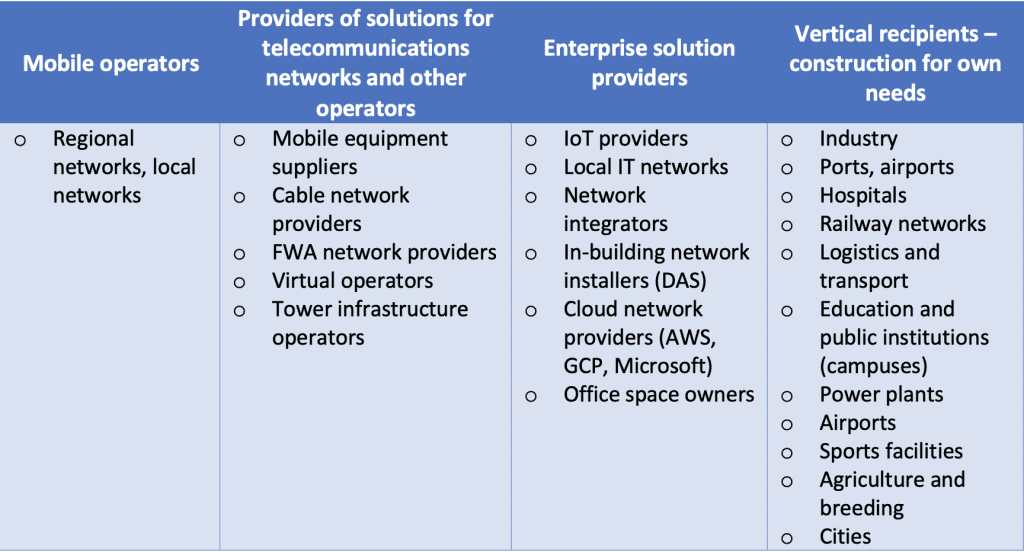
By far the largest sector is vertical customers.
This is due to scale.
Suppliers of the first three sectors are today building networks for their own needs.
However, they may soon become suppliers to the last sector or competitor.
Just like Meta (formerly Facebook) did.
Meta built its private network for its needs.
The network operates in all company branches in the USA
Based on these experiences, Meta decided to enter the market with a finished product.
Dedicated private networks.
This table will be useful when analyzing the solution model, described later in the article.
Why weren’t private networks established long ago and what caused this sector to grow so much?
A few years ago, the 3GPP organization responsible for telecommunications standards proposed the introduction of the standard.
What does the architecture of a private network look like? 3GPP standards? Version 16.
Standards for building a private network, or in fact a non-public network (Non-Public Network), apply to 5G technology.
The 3GPP standard takes into account two types of private networks:
- Stand-alone Non-Public Network (SNPN)* – an isolated private network.
- Public Network Integrated NPN (PNI-NPN) * – a private network integrated with the mobile operator’s network.
For those interested, here are the main sources of information about the architecture and functionalities according to 3GPP Standards: TS 23 501, TS 22.261, TS 22.263.
Before I present the network architecture, let me give you a heads-up.
Private mobile networks can also be built based on 4G frequencies and technology.
So there is no fear of limitation.
More on that later.
Private network architecture in the Stand-alone Non-Public Network, SNPN model. Advantages and disadvantages
The architecture of the SNPN network is very simple.
Drawing of the NPN architecture
The isolated network is designed according to 3GPP rel. 16 to offer data services, in a closed, isolated service space.
A very important note here.
This is exactly the architecture that has been approved for construction by UKE in Poland.
Your private mobile network should comply with this standard.
This version 16 model has its limitations.
Fortunately, standards are changing, as you will learn about in a moment.
Limitations of the SNPN model in the 3GPP version rel. 16.
The following features are not supported for SNPN:
- Cooperation with EPS – the standard assumes that it is a 5G only network. The same TS23 501 document defines certain interfaces that allow you to change this. More below.
- Emergency calls not supported (112)
- Lack of national or international roaming support.
- Handovers support between SNPN networks and MNO network
- No CIoT support (Cellular IoT like NB-IoT, LTE-M)
- No support for CAG groups (Closed Access Group). We use the mechanism in the second private network model (PNI-NPN).
These limitations make it impossible to apply this model to some solutions.
The basic SNPN network model is extremely limited in its scope and application.
However, isolated private networks are intended to be simplified.
Simplicity is an advantage in this case.
Technologically and cost-wise.
For other applications, a second network architecture model was created.
More on that in a moment.
First, let me introduce you to a certain trick and the second architecture of the 3GPP standard.
Voice calls in and out of the isolated SNPN private network.
The architects proposed a different, alternative solution for handling outgoing/incoming voice calls from a private network.
Drawing with N3IWF connection
In the figure, you will see that in addition to supporting standard 3GPP connections, the 5G architecture allows for connections of Non-3GPP solutions.
Interface calls N3IWF (Non-3GPP-InterWorking Function) is established.
Examples of N3IWF solutions are WiFi or LoRa networks.
Not only.
It can also be another IP network.
And suddenly, magically, a phone within the SNPN network can make a call from the operator’s PLMN network.
These are IP session-based connections.
There is one important thing, but…
The MNO (PLMN) must agree to such a service.
An inter-operator agreement is needed.
However, this is not the same as “supervision” through the PNI-NPN model.
Private network architecture in the Public Network Integrated NPN, PNI-NPN model. Advantages and disadvantages
Drawing of the PNI-NPN architecture
The architecture of the PNI-NPN network is much more complicated.
The biggest difference is the need to fully subordinate the private network to the interfaces and processes of the superior mobile operator.
This network model was created strictly for customers who want to establish cooperation with large mobile operators.
Advantages of the PNI-NPN network model
- Voice call support
- Roaming support
- Handover support
- Network slicing. Creation of parallel access networks for various classes of services (URRLC, mMTC ). Each slice manages QoS parameters.
- Controllable (in terms of area and identification) access to the private network for public network subscribers in private networks. And vice versa.
- CAG ( Closed Access Groups ) – a mechanism that allows you to control access to a private network. In the case of Network Slice, access could not be controlled without this change).
- The lower price of building a dedicated part of the network (IMS, VAS, Slice, etc.)
- Handling emergency calls 112
- Legal services provided Interception (country dependent)
- Support for subscriber processes within the operator’s network.
Disadvantages of the PNI-NPN network model
- SIM cards and HSS registers are available from the operator’s resources. For the owner of a private network, this means dependence, while for the mobile operator, it is a strong attachment, i.e. an advantage. Today, MVNE operators who base their networks on operator networks have a similar relationship.
- Dependence on the operating strategy of the mobile operator.
- Thinking ahead, it is difficult to implement changes or new xApps if MEC edge servers are located in the operator’s network and resources. This disadvantage can be minimized. Implement the MEC server on the SNI-NPN network side. However, xApps applications will still have to be integrated with the operator’s network in some sense (RAN, transmission, traffic control – superior UPF).
- Dependence on mobile operator suppliers. Roadmap products.
- Network supervision, partly in the operator’s company.
- Network Sharing – sharing the network by several operators.
Is this a bad model?
Of course not.
Many services can be offered in the PIN-NPN model, as long as the intention is to offer telecommunications services to other customers.
If we focus on our own needs, the first SNPN model is sufficient.
Moreover, as I mentioned, standards are changing and new functions are added to both models.
Private network architecture changes are planned in 3GPP version 17 and version 18 standards.
3GPP engineers understand the application limits of the network, mainly the SNPN architecture.
Work under the new standards is focused on several areas.
- Allowing subscribers from another network to join the private network. This was the biggest problem of the standard in version 16. The new version of the standard allows access to a terminal registered in an external register (CN). CN – Credential Holder, can be AAA or AUSF system with UDM. This is an interesting change because it means that not only the mobile operator can play this role.
- Access of subscribers of one private network to equivalent private networks. One owner may have several geographically located networks (cities, ports, factories).
- Voice calls are based on the IMS system. The SNPN network operator must install an expensive IMS platform. 3GPP is constantly looking for an alternative architecture solution in this area. As I mentioned above, alternative solutions can be used, but they are not natively integrated with the phone.
- Emergency call handling (112) based on the IMS system.
- Video, Image, and Audio call support for Professional Applications (VIAPA).
The basic and most important changes concern the SNPN network.
Are these changes critical?
In my opinion, they are necessary.
However, if we are building a private network based on access to our own devices and controlled by an internal application, the SNPN model is sufficient.
The market for private networks requires the support of 4G and 5G technologies.
During tenders around the world, I have come across many approaches to building integrated private networks.
The beauty of standards is that building a private network can be tackled in many ways, beyond just following the recommendations mentioned above.
You can modify the network architecture and operation as long as you can meet the customer’s needs.
This is confirmed by data from November 2023 presented by GSA.
If the 3GPP standards were applied literally, we could talk about networks only based on 5G technology.

This is not the case, because the 4G band is also a good band for building private networks.
Suppliers started looking for solutions based on 4G bands and fiddling with the network architecture.
This was mainly due to the lack of support for voice services in current versions of 3GPP standards for private networks.
Maybe enough of digging into standards.
Let’s see what services both models will offer in practice.
What specific service needs can private networks meet?
To understand who and what audience both architectures are for, I looked at it from the perspective of customer needs.
It is worth noting that the choice of the appropriate type of network depends on the individual requirements and budget of a given recipient.
Implementation can significantly improve communication and efficiency in many areas, but it must be tailored to the specific needs and conditions of a given enterprise or organization.
The table below shows the services with their main advantages and disadvantages based on both private network models.
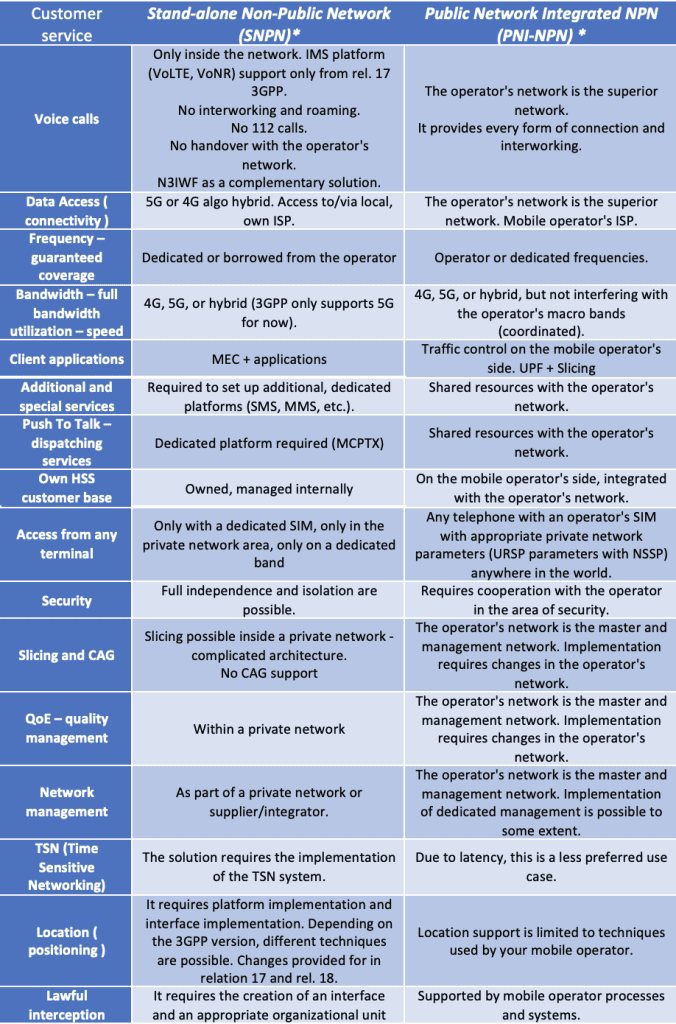
It is difficult to assess which solution is better for the client.
Each recipient may have a different need for the above-mentioned services.
The client may also have a different approach to the issue of cooperation and dependence on the superior operator.
On the one hand, as you can see, cooperation in the PNI-NPN model offers much greater opportunities, but it also requires the operator’s willingness and speed to implement changes.
I know from practice that a large operator does not put the needs of a small operator/customer first.
I do know one thing though.
5G technology and the emerging ubiquitous desire to use AI solutions require rapid adaptation of applications and services to the changing customer environment.
In such a world, the owner of a private network must be serviced according to the standards of ICT market providers, not mobile operators.
This is a defining requirement for private network providers.
Does building an SNPN network make sense?
Of course, it does, for example when building intelligent factories (industry 4.0).
This is shown by the number of private networks being created around the world in this industry.
You can build a closed, isolated, secure network to run your production lines.
However, the question arises whether it is possible to create an isolated network supporting voice calls, taking into account the 3GPP standards.
There are at least two ways.
Modify the network compliant with the standard or wait for subsequent versions of the standards.
What is the indispensable and most important element of a private network?
Band and frequency.
Band. The most important element of a private network.
A dedicated or borrowed bandwidth for a private network is Shakespeare’s “To Be or Not To Be”.
Everything starts with this possibility and ends there if there is no bandwidth.
You can build a private network based on an unlicensed band such as WiFi.
But it’s not about having only connections and no guarantee of quality (connectivity).
The game is about quality and full control of the network, for dedicated solutions.
Dedicated frequency band for private networks
A separate, dedicated band in a specific geographical area, but also the bandwidth, are extremely important parameter.
- Frequency is the ability to offer guaranteed, continuous coverage.
- Bandwidth is speed, especially with 5G networks.
regulators, such as UKE in Poland, play an important role in preparing the market for the development of private networks.
Offcom from Great Britain and the regulator from Germany can be cited as exemplary.
In Poland, we can also boast of access to bandwidth for private networks.
Many regulators around the world have understood this and are preparing bandwidth and procedures to lend to private networks.
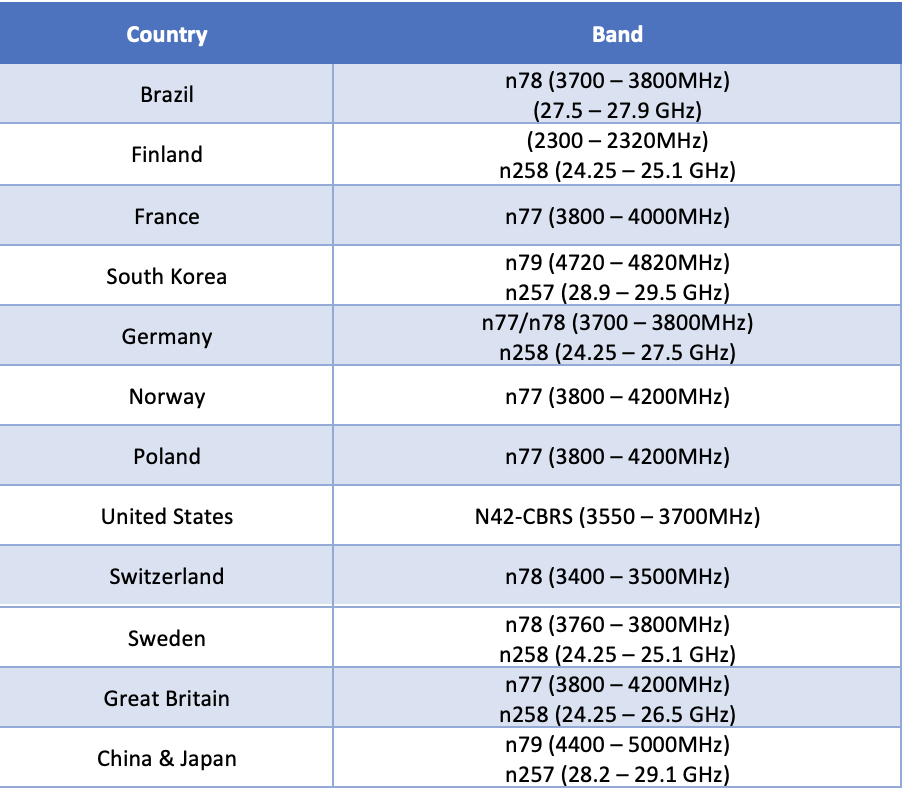
How has the allocation of private bands affected the number of implemented networks?

The above chart clearly shows that countries that have allocated private bands for networks are enjoying an “explosion” in the number of these networks.
We are talking about the USA, Germany, and the UK.
In the case of Germany, South Korea, and Japan, the largest percentage of the network is based on 5G technologies.
Poland is at the beginning of this path.
Frequency rental prices are attractive, which has resulted in the creation of many networks in these countries.
Additionally to the discussion about whether to “give” bandwidth, there is also a hot debate about how much of it to give to private networks.
In Germany, you can rent the C-band band with a width of 100 MHz.
In the USA, you can rent the 150 MHz CBRS band.
The best gift came from the Spanish government, allocating 450 MHz of the 26 GHz mmWave band.
The mmWave band is, of course, a completely different story.
This band offers opportunities for FWA providers.
In Poland, you can rent up to 100 MHz of dedicated bandwidth.
Shared bandwidth
But what to do if the regulator has not prepared a solution for a private network?
Likewise, what to do when the regulator has only allocated the 5G band and we want a 4G network?
In this case, there is one more solution.
Cooperation with a mobile operator or other band owner.
Business may become more difficult, but it is still possible.
In this case, there is an important note regarding the booking decision.
Not every band can be used for such purposes.
This is a possible approach.
This happens in other countries, with appropriate regulations.
Do operators have free frequency resources?
Or maybe they don’t use 100% of the bandwidth in their network in all counties and I can figure something out?
Mobile operators are maximizing the use of their mobile bandwidth, fighting for capacity and coverage.
Therefore, they are not willing to share such a good with a smaller partner and, sooner or later, a local competitor.
I know from practice that it is possible to isolate a “piece” of frequencies in a certain area, but providing a wide band is difficult.
However, this is a negotiated option in the case of the PNI-NPN model.
A network is dependent on a mobile operator’s network.
Private networks in sparsely populated areas. Shared bandwidth
The matter is simpler in sparsely populated areas.
The operator can allocate high frequencies with a wide bandwidth for this purpose.
Typically, the scope of such a network is local.
Private networks in urban areas. Shared bandwidth
The situation with the expansion of the operator bandwidth in the city is much worse.
As a rule, 100% of resources work for mass customers, for the operator’s services.
If a private network were to be established in the center of an agglomeration, a separate band is needed.
This rather closes this option.
Other aspects of band and frequency allocation
There are two more important aspects regarding the choice of band frequencies.
- Selection of frequencies for terminal operation. The most popular terminals definitely “look” for specific frequencies. Naturally, the operator uses these frequencies to operate its network.
- Availability of radio transmitters. Many RAN vendors have a limited product portfolio. O-RU in such cases may come from different suppliers, under different product development and FCAPS supervision regimes. The topic will be developed in another article.
Once you have your bandwidth for your Private Network, what do you do next?
I would like to remind you that the band is already available for purchase in Poland.
So let’s discuss the technology choices one by one.
And of course suppliers.
I will suggest that you familiarize yourself with a simple scheme for choosing the type of technology.
In another article, I will focus on the secrets of technology.
Is every band good for building a private network?
Theoretically yes, practically no.
Let’s look at the “popularity” of 5G frequencies used by mobile networks.

If we are thinking about building a closed, dedicated SNPN network, we can think about the selection of each band.
Of course, if a radio network and receivers (UE) supporting a given band can be purchased for such a band.
For example.
We need high-resolution industrial cameras with a CPE receiver/transmitter for a very unique band.
It may turn out that it is not impossible because no one produces such cameras.
This argument was raised several times during the Fyuz conference on Open RAN and neural networks.
Another example of difficulties in selecting radio equipment and EU terminals is the need to build a network for mass recipients.
Airports, stations, and campus networks.
Such a network should support as many terminals as possible used by recipients.
Therefore, in this matter, we need networks for bands that are usually used by mobile operators.
In this case, we are talking about building a network in the PNI-NPN model.
In critical cases, it may turn out that the private bandwidth is not supported by many terminals in the hands of customers.
This element of analysis when building a network is extremely critical.
Please always remember this.
We need to know for whom (devices) the network is to be created.
Criteria for selecting a Private Network and a Private Network provider
Data transfer?
Voice?
Or maybe even other services, such as applications supporting the factory owner’s machinery.
These requirements determine the choice of technical solution.
The most important elements of the strategy for choosing the type of technology used for a private network.
I have prepared some criteria when deciding on a solution for a private network.
I see this choice as follows:
- Frequency. If we even have a choice.
- Bandwidth.
- 4G network, 5G network, or both technologies (most complicated case)?
- Voice calls inside and/or outside the private network?
- Access your private network from any device?
- Is the network separated or shared with the operator?
- Network size. Local or distributed? Number of base stations.
- Model of network expansion, maintenance, and development?
These criteria will allow you to make a very important decision about which network model to choose.
In what architecture to choose a private network:
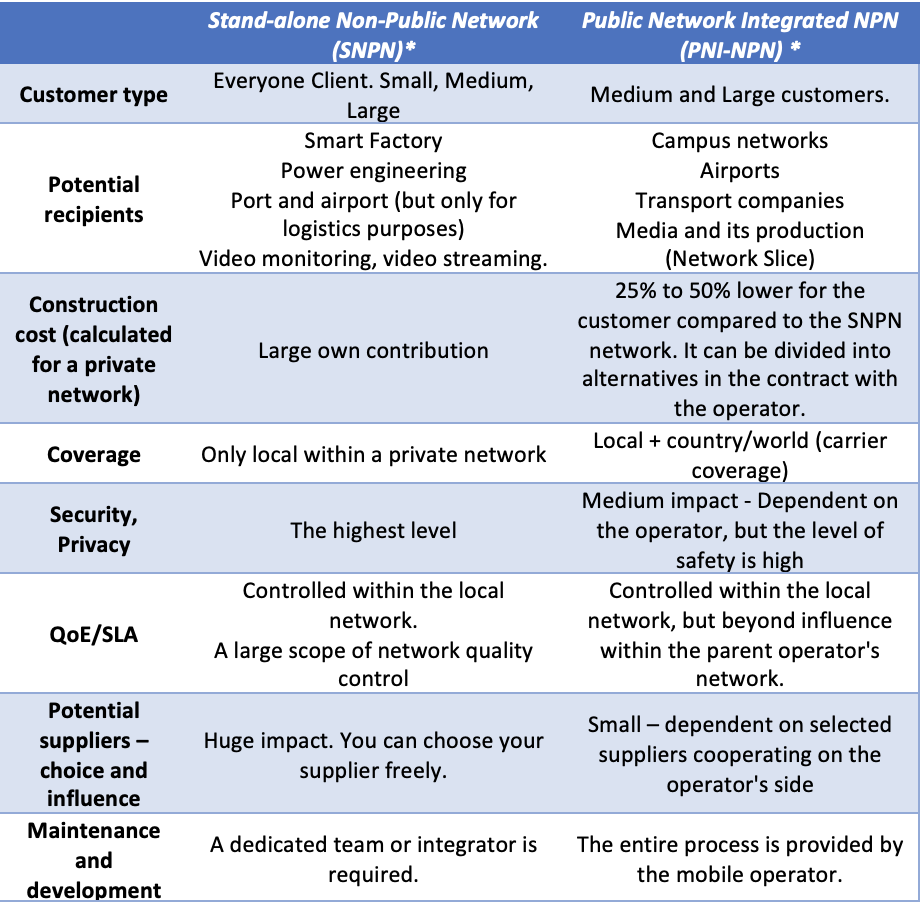
Choosing a Private Network Provider
The choice of supplier is partly the result of the decision on the type of network.
Roughly speaking.
The advantage of modern 5G/4G systems and the solution being based on a virtual environment allows for almost any choice.
Such flexibility is extremely important when making every single decision about supplier selection.
One of the projects in which I participated was not limited to choosing one solution.
The client was building a set of potential private networks for various audiences.
He decided to choose a few technological solutions from competitors.
Which provider should you choose to provide a Private Network?
The separation ( disaggregation ) of software from hardware and the adaptation of telecommunications platforms to IT solutions have changed a lot.
Today, even small companies are starting to produce telecommunications platforms based on 3GPP and Open RAN standards.
These technologies have expanded the market for private network solution providers.
I have divided them into different categories:
- Large telecommunications suppliers – Ericsson, Nokia, Huawei, ZTE, Samsung
- Alternative providers – Athonet, Casa, Rakuten Mobile, Mavenir, NEC, Fujitsu, etc., and many small Open RAN vendors.
- Public cloud providers – Amazon, Google, Microsoft. Yes, these companies have a huge appetite for the private network market. For this reason, Microsoft swallowed, among others, Affirmed Networks and Metaswitch. In addition to backbone (Core) and edge (EDGE) network solutions, they also offer dedicated radio solutions.
- Mobile operators will, of course, provide the solution in partnership with their large telecommunications providers.
- Operators infrastructure tower – Cellnex, SBA Communications, IHS Holding, Abertis, American Tower, etc. A new trend is called Neutrality Host. The standard of offering neutral networks to building owners or tower owners is currently changing a lot in this matter.
- Integrators systems – CapGemini, TechMachindra, HCL, TCS, Accenture, etc.
- End customer ( enterprise ) – possible in the case of companies such as Ericsson, Nokia, Bosch, or other alternative suppliers with appropriate in-house competencies.
Provider matrix versus recipient sector of Private Networks
I have prepared a general summary of the capabilities of individual suppliers.
I have collected all the information into one table that may help you understand certain decision-making aspects.
The rating in the table below shows the provider’s strengths or weaknesses compared to both 3GPP network models. Subjective scale from 1 to 4.
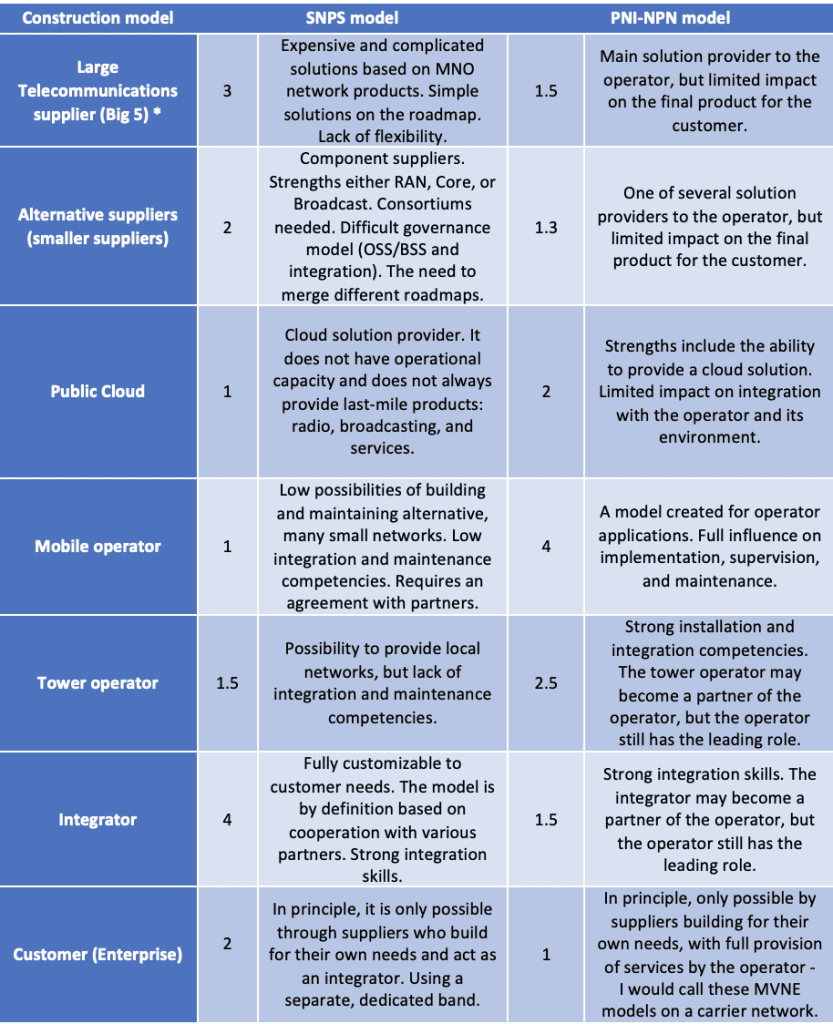
Scale: 1 – small impact… 4 – large impact.
What does the market for private network providers look like today?
Who deals the cards in the private network market today?
Finally, let’s check which segment of private network providers (Q4 2023) is the largest provider.
Not all information is available in the reports of analytical companies.
It is difficult for me to check which networks are built based on the SNPN model and which ones are based on the PNI-NPN model.
Analysys Mason report from H1 2023, the statistics are as follows:

Unfortunately, the data from this report is not consistent with the data from the GSA report.
However, if this report is to be believed, which was partially confirmed by T-Mobile, Vodafone, Telefonica, and Orange at the Fyuz 2023 conference in Madrid, then operators are the main suppliers.
In second place are large telecommunications equipment suppliers such as Nokia, Ericsson, and Huawei.
I indicated the order along with the number of projects.
Nokia is the leader in this subgroup.
The next place is taken by smaller integrators ( Specialist network providers ), mainly from the USA, where they implemented CBSR networks.
A final word.
If you are interested in exploring the topic and need help with it, I invite you to cooperate.
You can find the contact details at this link.